Build a Wireless Sensor Network Using NRF24L01 & Arduino
by RonFrtek in Circuits > Arduino
590 Views, 3 Favorites, 0 Comments
Build a Wireless Sensor Network Using NRF24L01 & Arduino

Here we are going to explore how to build a Wireless Sensor Network
Using NRF24L01 & Arduino, in this example we are going to use one NRF24L01 as a receiver and two NRF24L01 modules as a sender for the Temperature & Humidity using a DHT sensor.
The key point of this tutorial is to learn how to add ID to each of the modules so that the receiver can know which module is sending the data.
Also check out this amazing tutorial made by Boian Mitov Arduino and Visuino: Long Distance Remote Light Sensor With RFM95W/RFM98W Makerfabs LoRa Shields
What You Will Need
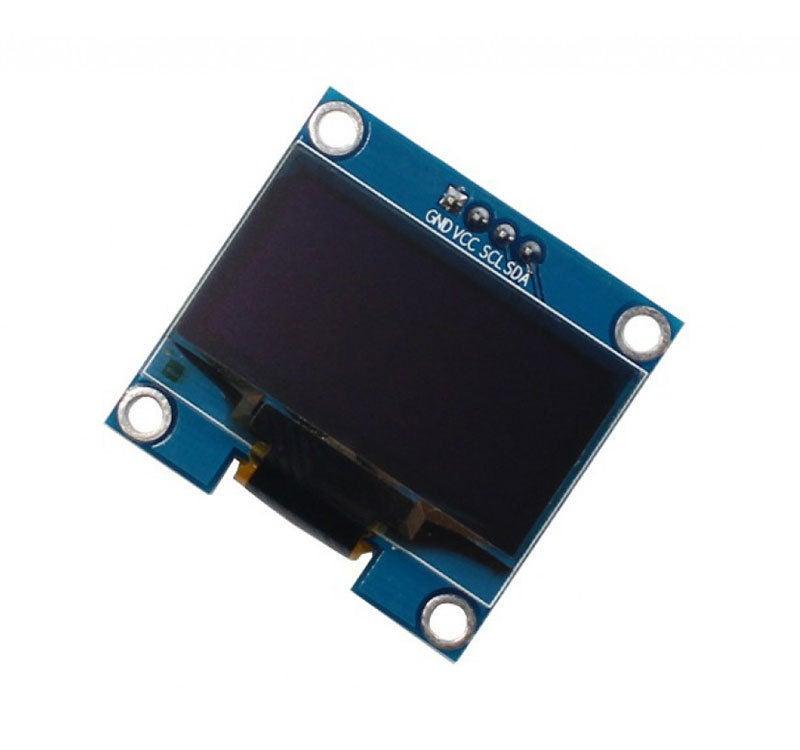
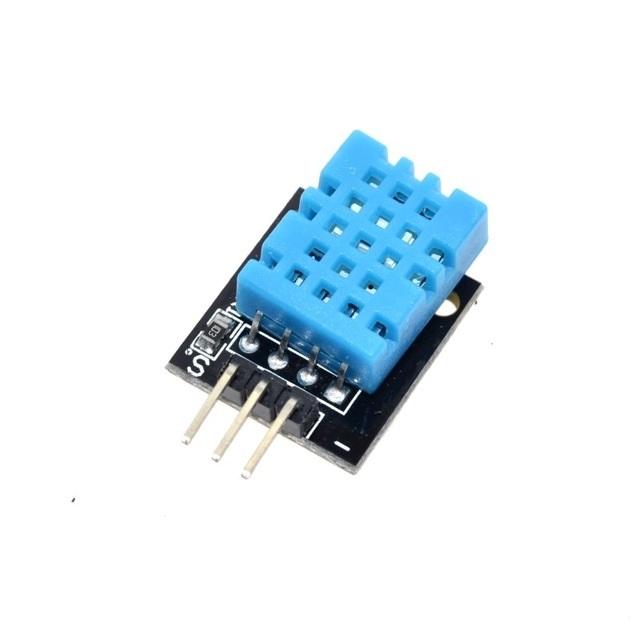
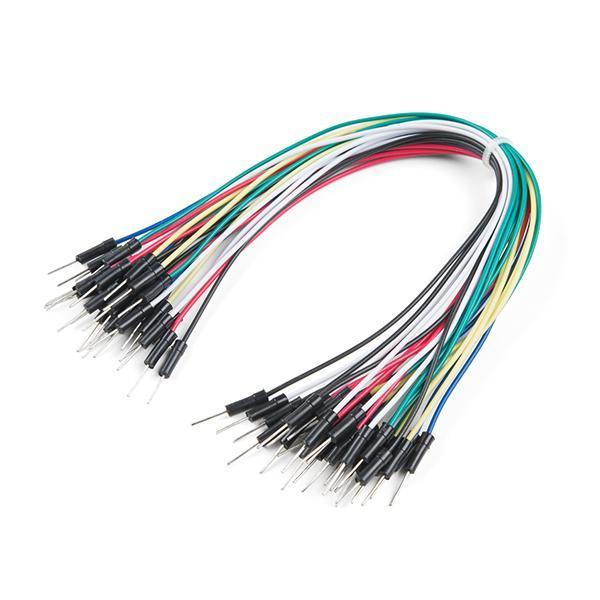
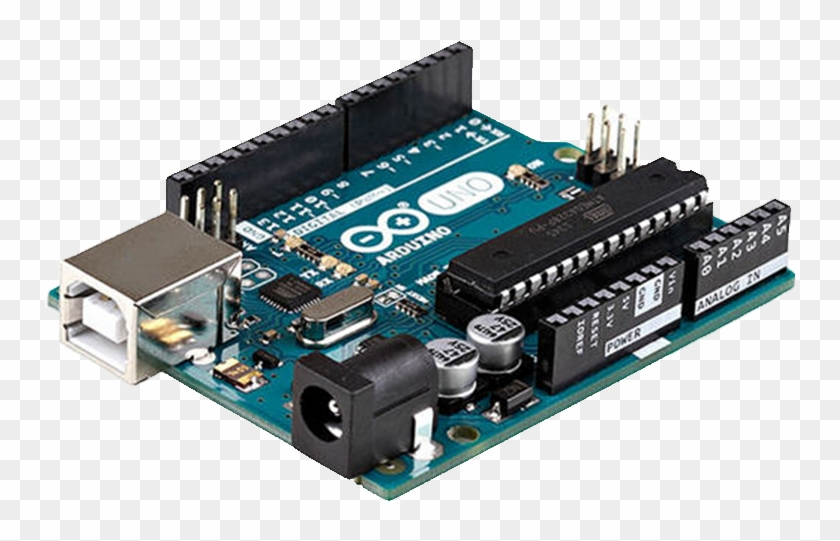



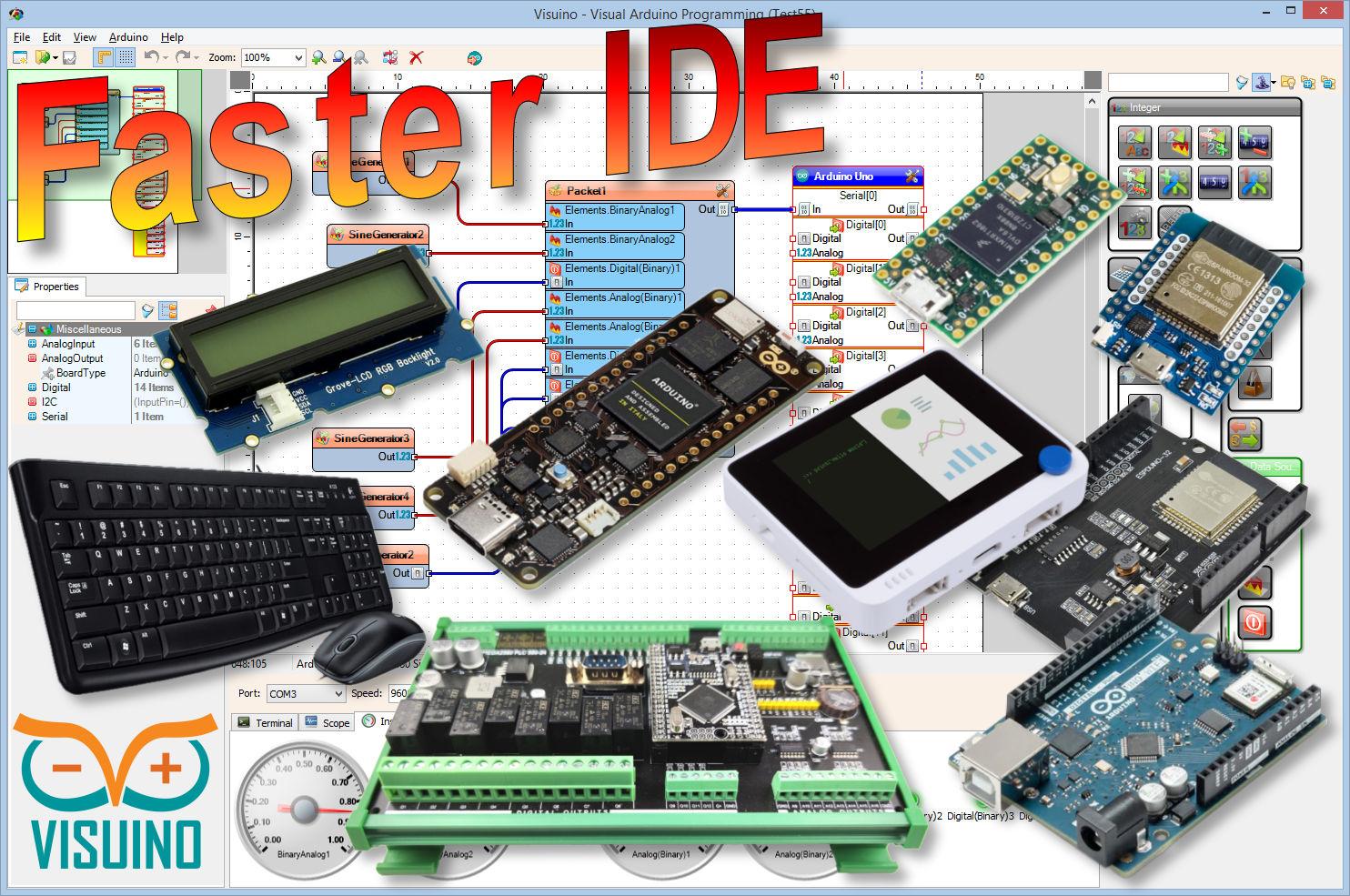
- 3X Arduino UNO (or any other Arduino)
- OLED Display
- 3x nrf24l01 module
- 2X DHT11 or DHT22 sensor (or any other sensors)
- Jumper wires
- Breadboard
- Visuino program: Download Visuino
The Circuit

For this project we are using a NRF24L01 module together with a voltage adapter.
Wiring the Sender 1 Arduino:
- Connect NRF24L01 Adapter pin [VCC] to Arduino pin [5V]
- Connect NRF24L01 Adapter pin [GND] to Arduino pin [GND]
- Connect NRF24L01 Adapter pin "Chip Enable" [CE] to Arduino Digital pin [9]
- Connect NRF24L01 Adapter pin "Chip Select" [CSN] to Arduino Digital pin [10]
- Connect NRF24L01 Adapter pin [SCK] to Arduino Digital pin [13]
- Connect NRF24L01 Adapter pin [MO] to Arduino Digital pin [11]
- Connect NRF24L01 Adapter pin [MI] to Arduino Digital pin [12]
- Connect DHT11 sensor pin [VCC] to Arduino pin [5V]
- Connect DHT11 sensor pin [GND] to Arduino pin [GND]
- Connect DHT11 sensor pin [OUT] to Arduino Digital pin [2]
Wiring the Sender 2 Arduino:
- Connect NRF24L01 Adapter pin [VCC] to Arduino pin [5V]
- Connect NRF24L01 Adapter pin [GND] to Arduino pin [GND]
- Connect NRF24L01 Adapter pin "Chip Enable" [CE] to Arduino Digital pin [9]
- Connect NRF24L01 Adapter pin "Chip Select" [CSN] to Arduino Digital pin [10]
- Connect NRF24L01 Adapter pin [SCK] to Arduino Digital pin [13]
- Connect NRF24L01 Adapter pin [MO] to Arduino Digital pin [11]
- Connect NRF24L01 Adapter pin [MI] to Arduino Digital pin [12]
- Connect DHT22 sensor pin [VCC] to Arduino pin [5V]
- Connect DHT22 sensor pin [GND] to Arduino pin [GND]
- Connect DHT22 sensor pin [OUT] to Arduino Digital pin [2]
Wiring the Receiver Arduino:
- Connect NRF24L01 Adapter pin [VCC] to Arduino pin [5V]
- Connect NRF24L01 Adapter pin [GND] to Arduino pin [GND]
- Connect NRF24L01 Adapter pin "Chip Enable" [CE] to Arduino Digital pin [9]
- Connect NRF24L01 Adapter pin "Chip Select" [CSN] to Arduino Digital pin [10]
- Connect NRF24L01 Adapter pin [SCK] to Arduino Digital pin [13]
- Connect NRF24L01 Adapter pin [MO] to Arduino Digital pin [11]
- Connect NRF24L01 Adapter pin [MI] to Arduino Digital pin [12]
- Connect OLED Display pin [SCL] to Arduino pin [SCL]
- Connect OLED Display pin [SDA] to Arduino pin [SDA]
- Connect OLED Display pin [VCC] to Arduino pin [5v]
- Connect OLED Display pin [GND] to Arduino pin [GND]
Start Visuino, and Select the Arduino UNO Board Type
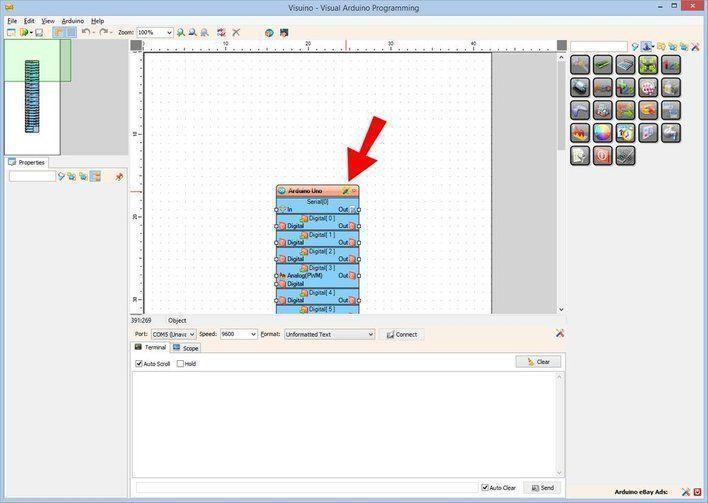
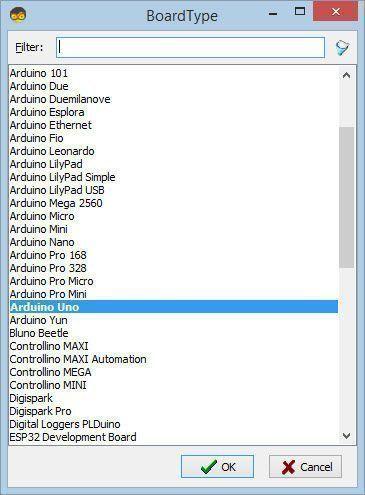
The Visuino: https://www.visuino.eu also needs to be installed. Download Free version or register for a Free Trial.
Start Visuino as shown in the first picture Click on the "Tools" button on the Arduino component (Picture 1) in Visuino When the dialog appears, select "Arduino UNO" as shown on Picture 2
For Sender1 Arduino - in Visuino Add, Set & Connect Components








- Add "Make Structure" component
- Add "NRF24L01" component
- Add "Add Packet Header ID" component
- Add "DHT" component
- Double click on the "MakeStructure1" and in the "Elements" window drag 2X "Analog" to the left side and close the "Elements" window
- Close the "Elements" window
- Select "HumidityThermometer1" and in the properties set "Type" to the sensor that you use, either DHT11,DHT22,etc
- Select "AddPacketHeaderID1" and in the properties window select "ID" and click on the 3 Dots button and in the "ID" window set a unique sequence of bytes that will serve as ID, like 34 67 (See Picture)
- Close the "ID" window
- Connect "HumidityThermometer1" pin [Temperature] to "MakeStructure1" > "Analog1" pin [In]
- Connect "HumidityThermometer1" pin [Temperature] to "MakeStructure1" pin [Clock]
- Connect "HumidityThermometer1" pin [Humidity] to "MakeStructure1" > "Analog2" pin [In]
- Connect "HumidityThermometer1" pin [Humidity] to "MakeStructure1" pin [Clock]
- Connect "HumidityThermometer1" pin [Sensor] to Arduino Digital pin [2]
- Connect "NRF24L011" pin Interface [SPI] To Arduino board pin [SPI]
- Connect "NRF24L011" pin [Chip Select] To Arduino board digital pin [10]
- Connect "NRF24L011" pin [Chip Enable] To Arduino board digital pin [9]
- Connect "MakeStructure1" pin [Out] to "AddPacketHeaderID1" pin[In]
- Connect "AddPacketHeaderID1" pin [Out] to "NRF24L011" pin [In]
Upload the Project to the Arduino Board (see the Generate, Compile, and Upload the Arduino Code step)
For Sender2 Arduino - in Visuino Add, Set & Connect Components








- Add "Make Structure" component
- Add "NRF24L01" component
- Add "Add Packet Header ID" component
- Add "DHT" component
- Double click on the "MakeStructure1" and in the "Elements" window drag 2X "Analog" to the left side and close the "Elements" window
- Close the "Elements" window
- Select "HumidityThermometer1" and in the properties set "Type" to the sensor that you use, either DHT11,DHT22,etc
- Select "AddPacketHeaderID1" and in the properties window select "ID" and click on the 3 Dots button and in the "ID" window set a unique sequence of bytes that will serve as ID, like 34 21 (See Picture)
- Close the "ID" window
- Connect "HumidityThermometer1" pin [Temperature] to "MakeStructure1" > "Analog1" pin [In]
- Connect "HumidityThermometer1" pin [Temperature] to "MakeStructure1" pin [Clock]
- Connect "HumidityThermometer1" pin [Humidity] to "MakeStructure1" > "Analog2" pin [In]
- Connect "HumidityThermometer1" pin [Humidity] to "MakeStructure1" pin [Clock]
- Connect "HumidityThermometer1" pin [Sensor] to Arduino Digital pin [2]
- Connect "NRF24L011" pin Interface [SPI] To Arduino board pin [SPI]
- Connect "NRF24L011" pin [Chip Select] To Arduino board digital pin [10]
- Connect "NRF24L011" pin [Chip Enable] To Arduino board digital pin [9]
- Connect "MakeStructure1" pin [Out] to "AddPacketHeaderID1" pin[In]
- Connect "AddPacketHeaderID1" pin [Out] to "NRF24L011" pin [In]
Upload the Project to the Arduino Board (see the Generate, Compile, and Upload the Arduino Code step)
For Receiver Arduino - in Visuino Add, Set & Connect Components


















- Add "OLED I2C" component
- Add "NRF24L01" component
- Add 2X "Split Structure" component
- Add 2X "Detect Packet Header ID" component
- Select "DetectPacketHeaderID1" and in the properties window select "ID" and click on the 3 Dots button and in the "ID" window set a unique sequence of bytes that you set for the Sender1, like 34 67 (See Picture)
- Close the "ID" window
- Select "DetectPacketHeaderID2" and in the properties window select "ID" and click on the 3 Dots button and in the "ID" window set a unique sequence of bytes that you set for the Sender2, like 34 21 (See Picture)
- Close the "ID" window
- Double click on the "SplitStructure1" and in the "Elements" window drag 2x "Analog" to the left side
- Close the "Elements" window
- Double click on the "SplitStructure2" and in the "Elements" window drag 2x "Analog" to the left side
- Close the "Elements" window
- Double click on the "DisplayOLED1" and in the Elements window drag 4X "Text Field" and 4X "Draw Text" to the left side
- select "Draw Text1" and in the properties window set "Text" to Sender1 and "X" to 30
- select "Draw Text2" and in the properties window set "Text" to Sender2 and "X" to 85
- select "Draw Text3" and in the properties window set "Text" to TEMP: and "Y" to 20
- select "Draw Text4" and in the properties window set "Text" to HUM: and "Y" to 40
- select "Text Field1" and in the properties window set "X" to 50 and "Y" to 20
- select "Text Field2" and in the properties window set "X" to 50 and "Y" to 40
- select "Text Field3" and in the properties window set "X" to 90 and "Y" to 20
- select "Text Field4" and in the properties window set "X" to 90 and "Y" to 40
- Close the "Elements" window
- Connect "NRF24L011" pin Interface [SPI] To Arduino board pin [SPI]
- Connect "NRF24L011" pin [Chip Select] To Arduino board digital pin [10]
- Connect "NRF24L011" pin [Chip Enable] To Arduino board digital pin [9]
- Connect "NRF24L011" pin [Out] to "DetectPacketHeaderID1" pin [In]
- Connect "NRF24L011" pin [Out] to "DetectPacketHeaderID2" pin [In]
- Connect "DetectPacketHeaderID1" pin [Out] to "SplitStructure1" pin [In]
- Connect "DetectPacketHeaderID2" pin [Out] to "SplitStructure2" pin [In]
- Connect "SplitStructure1" > "Analog1" pin [Out] to "DisplayOLED1" > "Text Field1" pin [In] and pin [Clock]
- Connect "SplitStructure1" > "Analog2" pin [Out] to "DisplayOLED1" > "Text Field2" pin [In] and pin [Clock]
- Connect "SplitStructure2" > "Analog1" pin [Out] to "DisplayOLED1" > "Text Field3" pin [In] and pin [Clock]
- Connect "SplitStructure2" > "Analog2" pin [Out] to "DisplayOLED1" > "Text Field4" pin [In] and pin [Clock]
- Connect "DisplayOLED1" pin [I2C] to Arduino pin [I2C]
Generate, Compile, and Upload the Arduino Code

In Visuino, at the bottom click on the "Build" Tab, make sure the correct port is selected, then click on the "Compile/Build and Upload" button.
Play
If you power the Arduino modules, the OLED Display connected to the Receiver Arduino will start to show the Temperature+Humidity from the First Sender and the Temperature+Humidity received from the Second Sender Arduino.
Congratulations! You have completed your project with Visuino. Also attached are the Visuino project files for Sender and Receiver, that I created for this Tutorial, you can download it and open it in Visuino: https://www.visuino.eu